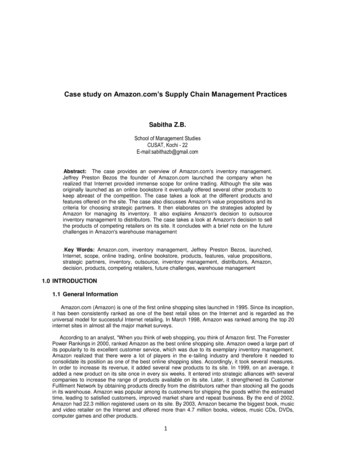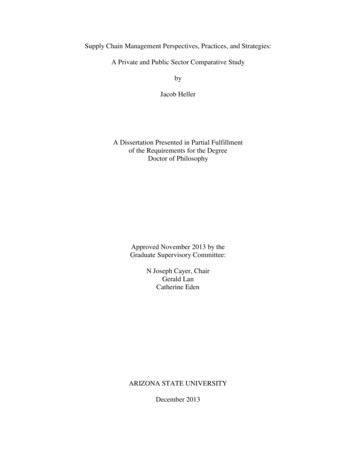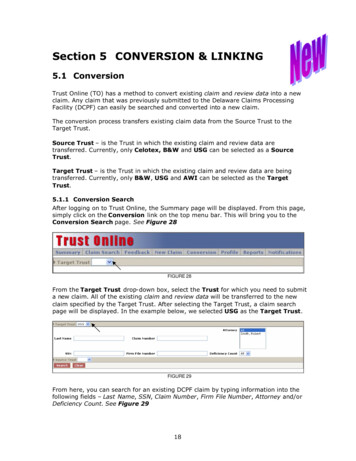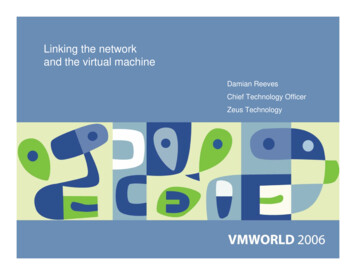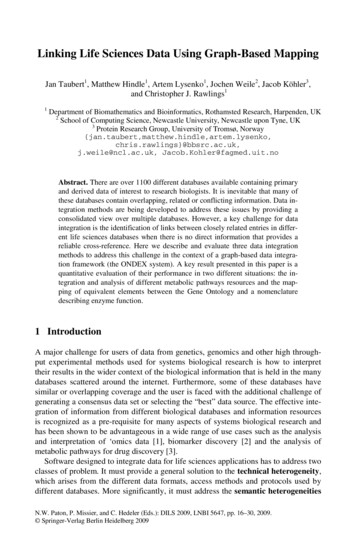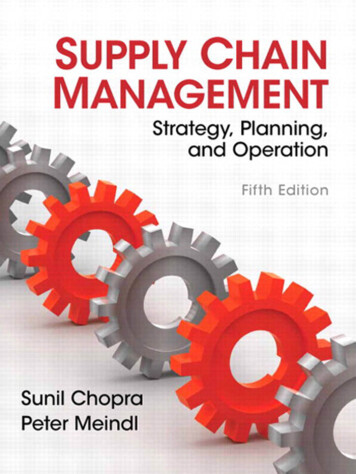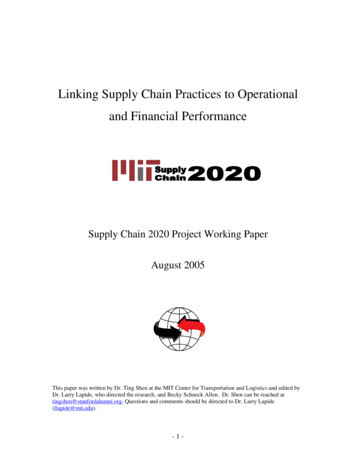
Transcription
Linking Supply Chain Practices to Operationaland Financial PerformanceSupply Chain 2020 Project Working PaperAugust 2005This paper was written by Dr. Ting Shen at the MIT Center for Transportation and Logistics and edited byDr. Larry Lapide, who directed the research, and Becky Schneck Allen. Dr. Shen can be reached attingshen@stanfordalumni.org. Questions and comments should be directed to Dr. Larry Lapide(llapide@mit.edu).-1-
1. Executive Summary . 31.1 Research Background . 31.2 SCM Practices that Link to Performance. 31.3 Operational Metrics Linked to Financial Performance. 51.4 SCM Practices Linked to Operational Performance . 61.5 Summary. 62. Introduction . 73. Summary of the Survey.113.1 Industry and Analyst Studies.12C1: Accenture - A global study of supply chain and its impact on business performance.12C2: AMR Research - The hierarchy of supply chain metrics.14C3: Booz Allen Hamilton - Capturing the value of supply chain management.15C4: Deloitte - Mastering complexity in global manufacturing .15C5: IBM/IndustryWeek -2003 IndustryWeek Value Chain Survey.17C6: McKinsey/Univ. of Munster - What factors give superior supply chain performance?.20C7: PRTM/SAP -Supply chain planning benchmark study.22C8: SAP/GA Tech - Quantifying the impact of supply chain glitches on shareholder value.233.2 Academic Studies.25A1: Financial benefits from JIT Adoption.25A2: Strategic logistics capabilities for competitive advantage and firm success.26A3: Supply chain management: Supplier performance and firm performance .28A4: Supply chain flexibility: An empirical study.28A5: Arcs of integration: An international study of supply chain strategies.30A6: Product variety, supply chain structure, and firm performance. .32A7: Supplier selection and involvement, customer satisfaction, and firm performance.33A8: Supplier selection and assessment: Their impact on business performance.33A9: The relationship between just-in-time purchasing techniques and firm performance .35A10: Effect of supply chain integration on diversification and performance.36A11: Supply chain management: Practices, concerns, and performance issues .37A12: Supply chain management: A strategic perspective .39A13: The influence of an integrated strategy on competitive capabilities and businessperformance: An exploratory study of consumer products manufacturers. .41A14: The effects of an integrative supply chain strategy on customer service and financialperformance.43A15: A Structural Equation Model of Supply Chain Management Strategies and firmperformance.44A16: Strategic purchasing, supply management, and firm performance.45A17: Complexity management and supply chain performance assessment: A field study and aconceptual framework.464. Opinion.484.1 Summary of the Linkages.484.2 Insights from the Study.55References.59-2-
1. Executive Summary1.1 Research ApproachThe Supply Chain 2020 (SC2020) Project is a multiyear research effort to identifyand analyze factors that are critical to the success of future supply chains. Phase I of theproject focused on supply chain excellence – researching the evolving business strategies,operating models, practices, and principles that are responsible for driving improvedperformance in companies today. To this end, we have surveyed twenty-five (25) studiesfrom both industry and academia to identify clear links between supply chainmanagement (SCM) practices and operational and financial performance.For each of the 8 consulting & analyst studies and 17 academic papers studied, welooked for three types of causal linkages or relationships: the link between SCM practicesand financial performance; the link between operational performance and financialperformance; and the link between SCM practices and operational performance.To identify trends across these distinct studies, we classified various factors thatcould be derived from each of the findings. We first classified the studies' financialperformance metrics into three categories: short-term financials, market share, and stockmarket. In addition, we classified five SCM practice areas: supply chain integration,complexity management, aligning strategy and supply chain, IT with processimprovement, and operational innovation. Lastly, we used six types of operationalperformance metrics: customer service, responsiveness, supply chain cost, assetutilization, product quality, and operational flexibility.In our analysis, we looked at the number of studies that corroborated any of thetargeted causal relationships. We then quantified each study’s credibility using aresearch quality index that assessed the strength of evidence supporting the causal link.This analysis helped provide a comprehensive and synthesized picture of which linkagesare credibly tied to a firm’s performance.1.2 SCM Practices that Link to PerformanceThe studies corroborate that several SCM practices are linked to firm performance.Of the five supply chain practice areas examined in our study, supply chain integration-3-
and complexity management show the most evident link to firm performance, with thestrongest link between supply chain integration and financial and operational metrics.The purpose of supply chain integration is to break down the “silos” across the wholesupply chain, allowing the firm to move closer to overall optimized rather than suboptimized management. Supply chain integration includes supplier-side collaborationsuch as information sharing, internal integration through cross-functional process teams,and customer-side collaboration through the integrating of customers’ needs and wantsinto the whole supply chain process. From the product perspective, supply chainintegration is reflected in integrated collaborative product development.Complexity management complements supply chain integration as integration itselfexpands the scope of the management issues and thus increases complexity. Complexitymanagement could include complexity-reducing methods, such as partnerships, long-termrelationships, and the rationalizing of product lines. Other complexity managementmethods do not reduce complexity but instead manage it through modularity andpostponement, which improves the efficiency and effectiveness of supply chains.Advanced information technologies can also enable companies to manage higher levelsof supply chain complexity.The combination of supply chain integration and complexity management is the keyenabler for companies to synchronize across customers, products, suppliers, andemployees, as well as across supply chain strategies and operations. Effectivelyapplying these two supply chain practices allows firms to move away from suboptimization and to create a profit cycle: a series of coordinated activities meant tosqueeze the greatest profit from each product or product line.This alignment of strategy and supply chain is becoming an important trend assupply chain management becomes more and more integrated into company strategies.Many practices we found in the literature, such as strategic purchasing or logisticscapabilities, confirm such a trend. Our study then confirms the impetus behind this trendby providing evidence that supply chain practices contribute to the financial performanceof a company, and therefore decisions regarding these practices should be made on astrategic-level.-4-
Our research also shows that when formulating these strategies, companies mustrealize that operational innovation is crucial if they want to gain competitive advantage insupply chain management. As Michael Hammer describes, operational innovation istruly deep change, affecting the very essence of a company: how its work is done. Theeffects ripple outward to all aspects of the enterprise. Breakthrough innovations inoperations can help destroy competitors and shake up industries, and ultimatelycontribute to the financial success of the company.1.3 Operational Metrics Linked to Financial PerformanceTo support profitability objectives, companies need to optimize supply chainperformance. Companies are challenged to continuously improve their performanceindicators and increase their compliances.Among operational metrics, customer service and responsiveness are the mostcritical; and through our research, we found these two metrics are also the most directlylinked to financial performance. In a world where customers are more demanding andsensitive about what they want, but have an unprecedented number of choices, servingthem with superior reliability and responsiveness is crucial to companies’ financialsuccess.Cost management does not rank far behind. As supply chain management extendswider girths of the value chain, cost management encompasses more components, and theeffective control of those supply chain costs is critical to a company’s bottom line.Supply chain cost includes inventory costs, logistics costs, and any other costs incurred toserve customers.Other operational metrics linked to financial performance include asset utilization,product quality, and operational flexibility. Asset utilization, such as inventory turns,measures how effective assets are being utilized and how they contribute to the financialstatus of a company. While product quality is a traditional measure, it is also critical to acompany’s long term survival and growth, and evidence shows it is directly linked tofinancial performance. Finally, operational flexibility measures a company’s agility tocope with the uncertainties and therefore improves the company’s ability to winfinancially in a highly-uncertain and super-competitive environment.-5-
1.4 SCM Practices Linked to Operational PerformanceWe also find that the supply chain practices we identified contribute significantly tothe above operational metrics, suggesting an indirect path from supply chain practices tofinancial performances.Our study suggests that in a world with growing complexity -- but abundantopportunities accelerated by globalization and information technologies -- companiesneed to closely integrate themselves into the supply network, carefully manage thecomplexity that ensues, align their business strategy with supply chain operations,leverage information technology with process improvement, and pioneer operationalinnovation for superior firm performance. Companies also need to rigorously executeagainst critical operational performance metrics, such as customer service,responsiveness, supply chain cost, asset utilization, product quality and operationalflexibility, in order to achieve overall business success.1.5 SummaryOverall, the 25 studies generally paint a picture of the supply chain challenge as acontinuously growing network of supply chain partners with incredible complexity,driven by product variety and globalization, and competing in a fast-changing and supercompetitive environment. Under these conditions supply chain management practices areshown as driving improvements to financial and operational performance. A supplychain has to be not only lean and efficient but also responsive and dynamic. Through ourresearch, we found the focus of SCM for most companies has shifted from cost reductionto the overall business impact and shareholder value. Therefore, new supply chainbusiness models and process innovation are required for continual improvements toprofitability and performance.-6-
2. IntroductionLong viewed as an operational function, supply chain management has become morestrategic to companies along with the trend of globalization and the growth ofinformation technology. During the 1990s, it moved from a logistics-focus dealingprimarily with warehousing, inventory, and transportation management to an integratedapproach that considers the management of goods flows and conversions from rawmaterial suppliers to consumers and product users. Leading companies such as Dell andWal-Mart are widely considered to have developed and leveraged integrated SCMconcepts to gain competitive advantage during this time period.The more strategic role of supply chain management could be manifested by itsstronger impact on companies’ operational and financial performance. This paper intendsto find such evidence by surveying both industry studies and academic literature toidentify the linkage from supply chain practice to operational and financial performance.This research is part of the ongoing MIT Supply Chain 2020 (SC2020) researchinitiative, which is predicated on the belief that the fast pace of change in outsourcing,product introduction, and customer expectations will only increase the importance ofsupply chain designs and operations. It is a multi-year research effort to identify andanalyze the factors that are critical to the success of future supply chains, and the Phase Iresearch is focused on understanding excellent supply chains. For any supply chain, theultimate measurements of excellence should include the operational and financial successdriven by the appropriate supply chain practices. Thus our study is an integral part of theSC2020 research initiative.The industry studies we surveyed were primarily conducted by leading consultingfirms such as Accenture, Deloitte, McKinsey, and PRTM, and research analysiscompanies such as AMR Research. Some of them were collaborative research effortseither among companies or with universities. Here we refer to them as consulting andanalyst studies. These studies identified key success factors, either supply chain practicesor operational performance metrics, through extensive surveys and data from publicdatabases. They also took a broad view and present a practical approach on how toachieve operational and financial success by integrating these factors. Most of theconsulting and analyst studies were conducted in 2003-2004.-7-
Table 1-1: Consulting and Analyst Study BackgroundNoSponsorThemeSample size /Stanford/INSEAD636 global 3000 companies in24 industriesAMR ivariateC2TabulationC3SurveyTabulationC4Booz,, AllenHamiltonDeloitteA global study of supply chainleadership and its impact onbusiness performanceAMR Benchmark Analytix(Benchmark Study)Capturing the value of supplychain managementMastering complexity in ,MultivariateC5IBM/Industryweek2003 IndustryWeek ValueChain SurveySurveyTabulationC6McKinsey/University of TM/SAPSupply Chain Champions: Whatfactors can give superior supplychain performance?Supply chain planningbenchmark study1,416 individual respondents,majority from manufacturing,distribution, and retailindustries.58 German companies inmanufacturing and retailSurvey,TabulationC8SAP/Georgia TechOver 60 companies, 75 supplychains of manufacturingindustries838 supply chain glitches(production delays or shippingdelays) of publicly tradedcompanies from 1989 to ing the impact ofsupply chain glitches onshareholder valueAbout 50 manufacturingcompanies196 manufacturing andindustrial companies689 companies inmanufacturing industries in 26countriesIn Table 1-1, we outline the sponsor, theme, sample size and demographics, datasources, and analysis method for each study. For data source, “Survey” means eitherpaper or electronic questionnaires are sent to targeted groups to solicit relevantinformation, and “Database” means objective data is obtained from public sources. Foranalysis method, “Tabulation” refers to using simple analysis such as taking the statisticalaverage and tabulating, and “Multivariate” refers to using regression and othersophisticated statistical methods to test certain hypotheses or draw conclusions.Among academic literature, we found 17 publications from 1996 to 2004 throughsearching the ABI/INFORM global database, which covers worldwide business andmanagement issues selected from more than 1,300 current business journals, professionalperiodicals, and most of the major academic publications in supply chain managementsince 1971. As the concept of supply chain management became popular only in themid-1990s, both the time frame and number of publications seem reasonable as it takesyears to accrue the data and evidence on how supply chain management impacts-8-
operational and financial success. As we can see from Figure 1-1, the overall trend ofpublications on the linkage between supply chain practices to operational and financialperformance is rising.Number of 32004YearFigure 1: Academic Publications on Supply Chain Managementand Firm Performance (1996-2004)In Table 2-2, we list the backgrounds of the academic studies, including the author(s),year, theme, sample size and industries, data sources, and analysis methods. A commonmethodology adopted by all 17 academic papers was to conduct a survey and thenperform statistical analysis on the data sample to test hypotheses regarding the linkageamong supply chain practices, operational metrics, and financial metrics. Regarding thetheme, most of the academic studies examine a “snapshot image” of supply chainmanagement compared with consulting and analyst studies.Table 2-2: Academic Study BackgroundNo. AuthorThemeSample Size and IndustriesDataAnalysis(Year)Source MethodA1 Balakrishnan Financial benefits from JIT adoption: 46 manufacturing firms adopted JIT Database Tabulation,et al (1996)A2A3A4A5Effects of customer concentration between 1985-1989 through annualand cost structurereport or 10-KMorash et al Strategic logistics capabilities for CEO responses from 65 small and large Survey,(1996)competitive advantage and firm U.S. furniture firmssuccessTan et al Supply Chain Management: Supplier 313 manufacturing firms, who are Survey(1998)performance and firm performance members of American Society forQuality Control (ASQC)Vicknery et Supplychainflexibility:An 65 responses form firms in the highly Surveyal (1999)empirical studycompetitive office and residential Databasefurniture industry.Frohlich and Arcs of integration: An international 322 responses in the 1998 International ,
Westbrook(2001)A6A7A8A9A10A11A12A13A14A15study of supply chain strategiesManufacturing Strategy Survey (IMSS)from 23 countries, focused onmanufacture of fabricated metal products,machinery and equipment.Randall and Product variety, supply chain Total 48 responses from U.S. bicycle SurveyUlrich (2001) structure, and firm performance: manufacturers in 1997.DatabaseAnalysis of the U.S. bicycle industryTraceyand Empirical analysis of supplier 180senior executives ofU.S. SurveyTan (2001)selection and involvement, customer manufacturing firms, who are subscriberssatisfaction, and firm performanceof IndustryWeek.Kannan and Supplier selection and assessment: 411 material and purchasing managers, SurveyTan(2002) Theirimpactonbusiness members of Institute for Supply(2003)performanceManagement (ISM) or AmericanProduction and Inventory Control Society(APICS).KaynakThe relationship between just-in- 382 firm responses who are the member Survey(2002)time purchasing techniques and firm of the American Society for Qualityperformance(ASQ) and ISM.Narasimhan Effect of supply chain integration on 623 responses from Korean and Japanese SurveyandKim therelationshipbetween manufacturing companies.(2002)diversification and performance:Evidence from Japanese and KoreanfirmsTan (2002)Supply chain management: Practices, 411 supply and materials managers of Surveyconcerns, and performance issuesmanufacturing firms, who are membersof ISM and APICS.Tan et al Supply chain management: A 101seniormanagersofU.S. Survey(2002)strategic perspectivemanufacturing firms among the membersof National Association of PurchasingManagement (NAPM)Rosenzweig The influence of an integrated 238 responses from consumer products Survey,et al (2003) strategy on competitive capabilities manufacturers of the 1997 VIM (Vision Databaseand business performance: An in Manufacturing) survey by Deloitteexploratory study of consumer consulting and Univ. of North Carolina.products manufacturersVickery etThe effects of an integrative supply 57 first tier large suppliers to NASurvey,al (2003)chain strategy on customer service automotive OEMs.databaseand financial performance: Ananalysis of direct versus indirectrelationshipsWisnerA structural equation model of556 senior managers in U.S. and Survey(2003)supply chain management strategies European manufacturing and serviceand firm performanceorganizations, who are members ofAPICS and NAPMA16 Chen et al Strategic(2004)purchasing,supply 221 purchasing managers, who are Surveymanagement, and firm performance members of ISM focusing on theindustries of fabricated metals, industrialand commercial machinery, electric trumentsandmeasurements equipment, etc.- 10 ion,Multivariate
A17 Peronaand Complexity management and supply Case studies with 14 Italian companies in Interview Tabulation,Miragliottachain performance assessment: A the household appliance industry.Modeling(2004)field study and a conceptualframeworkIn section 2, we summarize each of the industry and analyst studies and academicpapers. In section 3, we will synthesize the themes in the papers and discuss the insightsfrom our study. A list of key success factors of supply chain management that driveoperational financial success will then be presented.3. Summary of the SurveyIn this section, we summarize the content and identify three possible relationships foreach study: supply chain practices to financial performance, operational performance tofinancial performance, and supply chain practices to operational performance.We classify financial performance matrices into three broad categories: short-termfinancials, market share, and stock market. Short-term financials include costs, revenue,profit/profitability, return on assets (ROS), return on sales (ROA), etc. Market sharemetrics include actual market shares and other related measurements, such as growth rate.Stock market metrics include stock price, price change, earning per share (EPS), etc.For supply chain practices, we classified them into five broad types of practices:1. Supply Chain Integration includes integration with customers, with suppliers, andacross the internal organization. From the functional perspective, we also includeintegrated collaborative product development.2. Complexity Management refers to coping with supply chain complexity in a costeffective way.3. Aligning Strategy and Supply Chain implies that supply chain management is wellintegrated into the strategic planning of a company and thus a CEO-level agenda.4. Information Technology (IT) with Process Improvement means adoption of advancedsupply chain management software combined with process improvement.5. Operational Innovation means creating and implementing leading-edge practices andtechnologies in supply chain management.For operational performance metrics, we use the following six types of definitions:- 11 -
1. Customer Service includes the measurement of the quality of customer-facingactivities, such as on-time delivery and perfect order ratio.2. Responsiveness refers to the speed of response to customer needs and includesmeasurements such as lead time, delivery speed, and time-to-market.3. Supply Chain Cost represents the total cost to serve customers and its componentsincluding inventory cost, logistics costs, etc.4. Asset Utilization refers to metrics such as inventory turn.5. Product Quality refers to both the quality of the products and the quality of productbased services.6. Operational Flexibility measures an organization’s ability to satisfy customers’changing needs in a timely manner.3.1 Industry and Analyst StudiesC1: Accenture - A global study of supply chain and its impact on businessperformanceThe Accenture study (Accenture 2003, D’avanzo et al 2003) aims to understand howcompanies derive competitive advantage from their supply chains and tries to establish arelationship between supply chain performance and business success. By analyzingcorporate disclosure data from 636 Global 3000 companies in 24 industries andmeasuring three supply chain performance variables (inventory turns, cost of goods soldas a percent of revenue, and return on assets) in the period of 1995-1997 and 1998-2000,the study categorizes companies into four groups: Leaders, Transformers, Decliners, andLaggards -- based on the correlation between their supply chain performance andfinancial performance.In this study, compound average growth rate (CAVR) of market capitalization withinan industry, a type of market share metric, is used as the key financial performancemetric. The result strongly suggests a direct relationship between supply chain andfinancial performance, especially manifested by the linkage between inventory turns andCAVR. For our study, the linkage of cost of goods sold as a percent of revenue and- 12 -
return on assets to CAVR are not included, since these two variables are financial metricsby themselves.The study also shows that virtually all companies that improved their supply chainperformance (Transformers) had a higher growth rate in market capitalization in thesecond period. It confirms that tremendous opportunities for value creation andperformance improvement exist in almost all industries and suggests that seniorexecutives at leading companies view supply chain as critical drivers of shareholder valueand competitive differentiation. The drivers of operational performance improvementsinclude reducing supply chain cost, improving speed and efficiency, improving servicequality and product innovation, expanding channels and markets, and improving productquality and service innovation, which could directly contribute to financial performanceimprovement. Supply chain capability areas that provide the largest improvementopportunities are also identified in the study.After gaining an understanding of the value of supply chain operations, the study thengoes on to analyze the best practices of Leaders and finds that leading companiesincorporate supply chains into their business strategies and devote significant attention todesigning integrated operating models. An integrated operating model is often the key tosuccessfully balancing supply and demand across internal operations with supply chainpartners. It often incorporates world-class business processes in customer relations,supplier management, new product design, and core logistics operations.The study also finds that leading supply chain companies build innovation into theiroperating mode
The purpose of supply chain integration is to break down the “silos” across the whole supply chain, allowing the firm to move closer to overall optimized rather than sub-optimized management. Supply chain integration includes supplier-side collaboration such as information sharing, int


